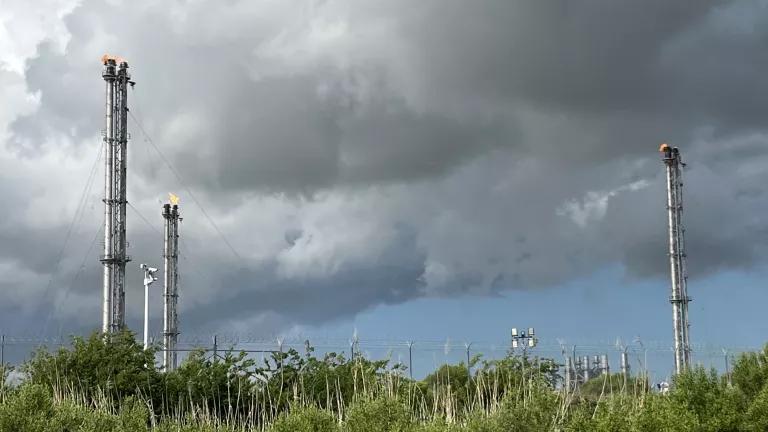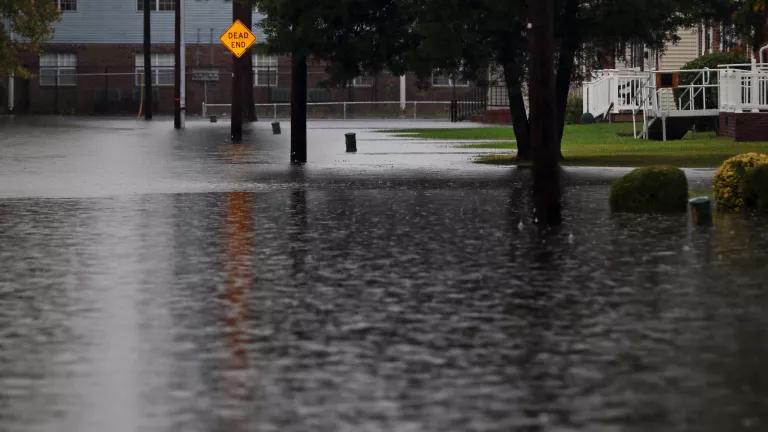The Texas Storm That Proved the Need for Grid Investments
It has been a year since Winter Storm Uri left millions of people without power. The United States cannot wait any longer to invest in its aging transmission system.

Karla Perez and Esperanza Gonzalez warm up by a barbecue grill during the power outage in Houston in 2021.
UPDATE: On February 13, Grid Strategies released its latest report that documents the dramatic benefits of the new transmission investments likely to come from Build Back Better. The report finds that the tax credit alone could drive $37 billion in transmission investment, leading to $75 billion in net consumer benefits. This investment could drive more than 50 Gigawatts of new transmission lines—more than was built in over the last decade in Texas and the central U.S.—to enable national wind generating capacity to nearly double. As the report notes, transmission planning and cost allocation analyses do not currently take these reliability, resilience, and consumer benefits into account, an issue the Federal Energy Regulatory Commission is currently in a position to fix. But federal action is still needed to spur significant, much needed transmission expansion in the U.S.
It has been a year since Winter Storm Uri left millions of people without power. The United States cannot wait any longer to invest in its aging transmission system.
One year ago, Winter Storm Uri plunged Texas and much of the central United States into a deep freeze.
As a result of planning failures, the Texas electricity system buckled, and more than 4.5 million Texans went without power for days. Tragically, at least 246 people died. The state’s economy suffered $195 billion in damages, making it the largest disaster in state history.
The lesson from Texas is that relying on gas poses serious risks, and that a strong, nimble grid is absolutely essential. During Uri, the gas system failed in each and every way when it was needed most. According to a Federal Energy Regulatory Commission (FERC) and North American Electric Reliability Corp. (NERC) report on the outages, natural gas fuel supply issues caused 87 percent of the outages, as gas production wells froze up, pipelines failed to function properly, and uninsulated gas plants couldn’t deliver power, even if they got fuel.

Source: "The February 2021 Cold Weather Outages in Texas and the South Central United States," a FERC, NERC and Regional Entity Staff Report
But the storm also highlighted the critical role of the power grid in delivering the energy we need to sustain our lives and showed what happens when the grid isn’t up to the task. According to the FERC-NERC report, Texas suffered the worst outcomes in large part because most of the state is an electrical island with very limited connections to neighboring states. With no transmission crossing state lines, it could not lean on its neighbors for power. Unlike in Texas, the power operators in the Great Plains and Midwest were able to import power from their neighbors to keep the power on. While improvements in the grid are needed nationwide, this import capability likely saved these residents from the disastrous consequences suffered by Texans.
No single power source is infallible, but a nimble and resilient grid can deliver electricity across the country from the producers that have it to the areas that need it.
Historic Opportunity with Build Back Better
With climate change bringing more extreme storms like Uri, we urgently need strong investments in the grid of the future. The bipartisan infrastructure legislation was a first step. Thankfully, Congress is considering the Build Back Better agenda that would make historic investments in transmission.
More transmission lines are crucial for a resilient power grid; they also save consumers money. A 2021 Grid Strategies report shows that each additional gigawatt of transmission ties between the Texas power grid and the southeastern United States could save Texas consumers nearly $1 billion on their electric bills. The report also shows that consumers in the Great Plains and Gulf Coast states could save at least $100 million per state with an additional gigawatt of transmission ties to power systems to the east.
Sadly, this is not the first time that additional transmission could have ensured reliability and resilience during a winter storm. A study showed that the eastern states could have saved $30 to $40 million per region for each gigawatt of stronger transmission ties among themselves or to other regions during the Bomb Cyclone cold snap in 2017–2018. Transmission also provides additional reliability while saving consumers on energy costs during heat waves.

Stated differently, a recent Department of Energy (DOE) study showed that electric outages cost the United States approximately $150 billion each year—about $500 for every man, woman, and child. Many of these outages occur on distribution lines—those that connect to homes and businesses. But many also occur on transmission lines, which are the interstate highway system of the grid.
DOE Ramping Up Transmission Efforts
This doesn’t have to continue. We know the problem; we need to start moving toward the solution. These extreme weather events are not going away. And we know that building out the transmission system results in greater grid reliability and resilience at lower cost to consumers. A lot is already being done to spur transmission investment. The Infrastructure Investment and Jobs Act passed last year included about $5 billion for new or expanded transmission, including:
- permanent borrowing authority from the Department of the Treasury for a DOE program to support construction of nonfederal electric transmission lines and other facilities;
- funding for resilience grants, including those related to transmission, such as “the replacement of old overhead conductors and underground cables” and “the relocation of power lines or the reconductoring of power lines with low-sag, advanced conductors”; and
- expanding the Smart Grid Investment Grant Program, which focuses on investments that improve the flexibility of the grid. These include upgrading existing transmission and distribution systems and other actions, like deploying energy storage.
The DOE is moving quickly to put these measures into action. Last month, it announced the Building a Better Grid Initiative to identify and support the build-out of critically needed transmission.
While impressive, that work alone will not be enough to build the transmission we need to save lives, strengthen our economy, fight climate change, and save customers money. We have a historic opportunity to invest in the transmission the nation desperately needs for reliability and resilience. Congress still hasn’t passed the Build Back Better bill, which would significantly increase support for desperately needed transmission. The bill would provide a 30 percent tax credit for regionally significant transmission, additional loans and grants for transmission, economic development support for host communities, technical support for siting authorities, and funds for studies on interregional transmission.
Reliability and Resilience
Such transmission investment would increase the reliability and resilience of the grid, reducing the catastrophic results we saw last year during Winter Storm Uri and the storms before it. Transmission alone will not prevent electric outages. But, as we saw during Uri, the Midwest and Great Plains states largely avoided the widespread power outages and the human and economic costs that came with them.
The nation cannot wait any longer to invest in the aging transmission system. The direct benefits of transmission investment are clear: increased reliability and resilience and reduced consumer costs. Building new transmission will also reduce the untenable human and economic costs of electric outages caused by ever-increasing extreme weather, such as that endured in Texas last year. No American should freeze to death because the transmission system fails them. We can fix that by building out the transmission system while also reducing total consumer costs for power. The transmission provisions in Build Back Better are one way to ensure this work gets started as quickly as possible.


